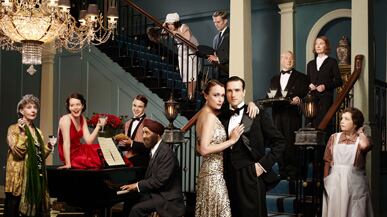After 36 years, Upstairs Downstairs returns to American television on Sunday with new characters and the original co-creators checking into 165 Eaton Place. Jace Lacob talks to the cast.
When Upstairs, Downstairs went off the air in 1975, the luxurious house that the Bellamy family inhabited at 165 Eaton Place in London was closed up, seemingly forever. But 36 years later, amid a resurgence of period-drama popularity, Upstairs Downstairs returns to American television with a new three-episode season—written by Heidi Thomas ( Cranford) and directed by Euros Lyn ( Doctor Who)—just in time for the show’s 40th anniversary and, coincidentally, that of Masterpiece, PBS’ signature franchise, as well.
Gallery: 40 Years of Masterpiece

In the United Kingdom, the new Upstairs Downstairs (now without a comma) ran in December over three nights on BBC One, scoring an average audience of 8.4 million viewers. (Longtime viewers will recall that the original aired on ITV, now the home to period drama rival Downton Abbey.) Six additional episodes have since been commissioned by BBC and will air sometime in 2012.
“We’re not stepping into anybody’s shoes,” said Keeley Hawes ( Ashes to Ashes), who plays the wealthy Lady Agnes Holland. “We are not recreating characters. It’s all fresh and new. And 35 years is a long time in television ... From the way it’s shot to just about everything, it’s different, inevitably.”
Ed Stoppard ( Brideshead Revisited), who plays debonair diplomat Sir Hallam Holland, agreed, but admitted that the original show has a special place in the hearts of television viewers. “ Upstairs, Downstairs is one of those things,” he said, “that’s now almost hardwired into the DNA of the British people.”
The same is true for American Anglophiles as well. Airing from 1971 to 1975 on ITV and on PBS stations in the United States, the show—the brainchild of actresses Jean Marsh and Eileen Atkins—depicted two very different but codependent existences occurring beneath the same roof: the luxurious Edwardian existence of the well-heeled Bellamy clan upstairs and the back-breaking drudgery of the servants downstairs.
Upstairs, Downstairs was groundbreaking in its focus on those polishing the silver and sweeping the grates as well as on those upstairs. Not surprisingly, both Marsh and Atkins had a parent who worked in service, and the drama paid homage to the men and women whose hard work and discipline had kept the great houses of England running smoothly.
Marsh ( Sense and Sensibility), who, in addition to being one of its creators, co-starred in the original, reprises her role as Rose Buck here in the sequel, set in 1936, six years after the end of the 1970s drama. Now running a servants employment office, Rose becomes the housekeeper to the new aristocratic family living at 165 Eaton Place.
While Hawes, Stoppard, and the rest of the cast—which includes Claire Foy, Adrian Scarborough, Anne Reid, Art Malik, Ellie Kendrick, and Neil Jackson, among others—are playing characters new to the franchise, Marsh is reprising a past role more than three decades later.
“It was emotional,” Marsh said, relaxing on a sofa at the Langham Hotel in Pasadena. “At the read-through, I sat between the butler [Scarborough] and the cook [Reid]. I thought, this is all right; I think Gordon Jackson and Angela Baddeley [from the original cast] would approve of them. But stepping onto that set on my own, I thought, fantastic. It was reproduced beautifully, but the kitchen is much better than the one was before.”
Marsh’s co-creator, Dame Eileen Atkins (Cranford), didn’t appear in the original, but she turns up here as Lady Maud Holland, the eccentric mother to Sir Hallam (Stoppard) who arrives from India with a monkey named Solomon, a studied manservant, and a host of secrets. Atkins was originally supposed to be in the original (“Sarah was written for her, originally,” said Marsh), but had to bow out due to a stage role.
“I could hardly be a young, juicy maid now,” said Atkins, laughing. “I was very nervous about being in it at all because you think, you didn’t do it the first time and maybe you better leave it alone now. I was very much persuaded into doing it. I wanted to be downstairs and I begged to play the cook as I did in Gosford Park. The general public prefers the downstairs, hard-done people than the posh people… I said, ‘I’m not going to play a boring old bitch upstairs.’ I argued and argued, so my playing Maud came out of a lot of argument really.”
Upstairs Downstairs arrives right on the heels of a highly rated competitor, Downton Abbey—which ended its run with a record 10.1 million viewers in the U.K. and an average of more than 6 million in the U.S., double the audience average for Masterpiece—the Edwardian costume drama created by Julian Fellowes, whom Atkins worked with on his Academy Award-winning film, Gosford Park. (In fact, Atkins said that she and Marsh were offered the chance to write Gosford and turned it down before the job went to Fellowes.) The British press has made a big deal out of the rivalry between the two shows, which alternated between friendly and unsportsmanlike.
The opening salvo was launched when Marsh appeared on BBC One’s The One Show and insinuated that it wasn’t a coincidence that the two shows were launching at about the same time. (Marsh on the timing: “It might be a coincidence and I might be the queen of Belgium.”) Downton star Hugh Bonneville took to Twitter to offer his take on Marsh’s comment, beginning by saying, “I thought Jean Marsh was bigger than that—running down Downton while bigging up Upstairs? Downton never downed Up when upping Down.”
Still, Marsh maintains the entire exchange was blown out of proportion by the press. “They take an innocent remark and run with it and create a rivalry that doesn’t really exist,” said Marsh about the Downton Abbey discord. “Of course, it’s a descendent of Gosford Park and, of course, Gosford Park was via Upstairs, Downstairs. I was quite pleased though to be tweeted at by Hugh Bonneville, who said I need a huggle and to sit in a friendly chair. I’m not quite sure what that means, but if he’s going to give it to me, I’m all for it.”
Atkins agreed. “I don’t think anything has ever been killed by there being two of it,” she said. “If there can be nine detective story series, there can be two period dramas. They’re terribly different.”
The two series do very different things. Whereas Downton focuses on the country manor set, far removed from the realities of the day (save for when events—such as the sinking of the Titanic or the start of WWI—intrude on their lives), Upstairs Downstairs tightly laces together the personal and domestic with the truly global, depicting first hand the rise of Fascism in England (courtesy of Oswald Mosley and the Battle of Cable Street), Down’s Syndrome, anti-Semitism, rising tensions with Germany, and more within its three-episode run, as the Hollands cross paths with historical figures including Foreign Secretary (and later Prime Minister) Anthony Eden, Wallis Simpson, and the Duke of Kent. Hell, there’s even a Nazi—that would be German foreign minister Joachim von Ribbentrop—setting foot inside 165 Eaton Place, which becomes a hotbed for political debate, thanks to chauffeur Harry Spargo (Jackson) and Lady Agnes’ troubled younger sister, Lady Persie (Foy).
“We’re all aware of the abdication or the rise of fascism, but it’s interesting to see it affecting people’s lives,” said Stoppard. “Fascism: what does that mean, really? But to actually see the Cable Street riots or see an individual in a household taking on that ideology, I think that’s fascinating.”
Despite its period trappings and issues of etiquette and precedence, Upstairs Downstairs connects us to not only the past but our own lives as well. While the series is set 75 years ago, the issues that the Hollands and their servants encounter—childlessness, ideology, war, regrets—are the same we face today, a similarity that the show shares with Downton Abbey as well.
“The 1930s aren’t actually that long ago,” said Hawes. “Agnes is a politician’s wife with exactly the same sort of worries that somebody like Samantha Cameron or the Obamas would have now, or anybody in that world. They have to keep up appearances, they have to be seen doing the right thing, yet suddenly all these skeletons start coming out of the cupboard.... That’s life and things happen and you deal with them and it’s not all a bed of roses.”
Which is, in a lot of ways, a modern idea that might jibe with both the inhabitants of 1930s London as well as modern viewers. Still, Atkins admitted that, given the society we live in today, Upstairs Downstairs could have done with an extra dose of sensuality.
“I just wish there had been more sex,” she said, leaning forward conspiratorially. “[Foy’s Lady Persie] likes the chauffeur for a bit of rough trade. From what I can remember, of course not from my own dealings, rough trade means you don’t lie on somebody’s lap and suck their fingers. I did think, oh, for goodness sake, get into bed. Let’s see some skin.”
Jace Lacob is The Daily Beast's TV Columnist. As a freelance writer, he has written for the Los Angeles Times, TV Week, and others. Jace is the founder of television criticism and analysis website Televisionary and can be found on Twitter. He is a member of the Television Critics Association.






